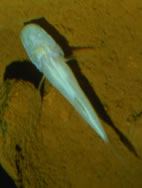With an estimated 27,977 species, fish are the most numerous and diverse group of vertebrate species. In fact, there are more fish species than all other groups of vertebrates (amphibians, reptiles, birds, and mammals) combined. Not surprisingly, fish inhabit almost every aquatic ecosystem on the planet. But, in some of the places that fish live – dry deserts, extraordinary pressure, absolute darkness, below-freezing temperatures, and harsh acidity – it’s hard to imagine that anything can survive. Here’s a short list of some of the MOST EXTREME FISHES:
DRY: Longfin Dace (Agosia chrysogaster)

A fish out of water seems like an oxymoron, but some fish are adapted to withstand even the driest environments. In situations of extreme drought, when evapotranspiration has removed almost all surface water from their streams, Longfin Dace (Agosia chrysogaster) have been observed, alive, under damp algae mats during the day and then swimming around in the few millimeters of water produced by dew during the night and early morning with in these drought conditions.
DEEP: Abyssobrotula galatheae

In the deepest parts of the ocean, water pressure is equivalent to the weight of an elephant over the area of a postage stamp. Yet, fish are adapted to even live at these depths. The deepest fish ever found was dredged from the bottom of the Puerto Rico trench at a depth of 8,370 meters (over 5 miles). For reference, if Mount McKinley (Denali) were placed at the bottom of the trench, it would still be more than a mile (over 2,000 meters) underwater. This fish, Abyssobrotula galatheae, is equipped with physiological modifications to allow it to withstand the pressure of the deep sea.
DARK: Blindfish (family: Amblyopsidae)

Though deep sea fishes routinely live in pitch black conditions (not even twilight penetrates deeper than 1,000m), the same is not the case for freshwater fish. A whole family of fish, blindfish (Amblyopsidae), however, have adapted to living in dark freshwater environments of swamps and caves. The fish in this family are totally blind; some can only detect the difference between light and darkness, others lack eyes entirely. Some of the species even lack pigmentation. Rather than navigate by eyesight, these blindfish rely on sensory papillae to observe their dark environment.
COLD: Antarctic Toothfish (Dissostichus mawsoni)

Most fish (and other organisms!) would freeze to death after a few moments in the environment in which the Antarctic Toothfish (Dissostichus mawsoni) thrives. Temperatures are routinely below the freezing point of fresh water (salt water freezes at lower temperatures than fresh water, depending on its salt saturation). The Antarctic Toothfish has evolved a number of adaptive traits, including a slow heartbeat (only once every six seconds) and an antifreeze glycoprotein to keep its blood from freezing in, literally, sub-freezing waters.
ACIDIC: Japanese Dace (Tribolodon hakonensis)

The Japanese Dace (Tribolodon hakonensis) prospers in the acidic waters of Lake Osorezan in Japan where the pH can range from 3.8 down to 3.4. Essentially, these fish swim in the equivalent of a giant bowl of vinegar. While long-term exposure to these conditions is toxic and generally fatal to most fish, the Japanese Dace have evolved the ability to correct plasma pH and minimize loss of essential salts to thrive in their acidic environment.

Phreatichtys. – pitch black and hotter than all heck! Like 35 degrees!
Well, the pressure actually is not anything that counts as a particular challenge. If you “grow up” there, then that pressure is inside you as well as outside and the overall balance is zero (which is why these fish “explode” if brought up to the surface and which is one reason we know so little yet about the potential abundance of live at these depths). All your other examples, esp. the cold, acidity and drought adaptation, are extreme examples, the pressure problem though is much less of an obstacle to colonization.
Great site and love the details on here. I really appreciate your efforts and i am waiting for your next write up. Thanks for sharing this wonderful article this article is very helpful for me thanks again…
Pheasants Forever Branded Windmills